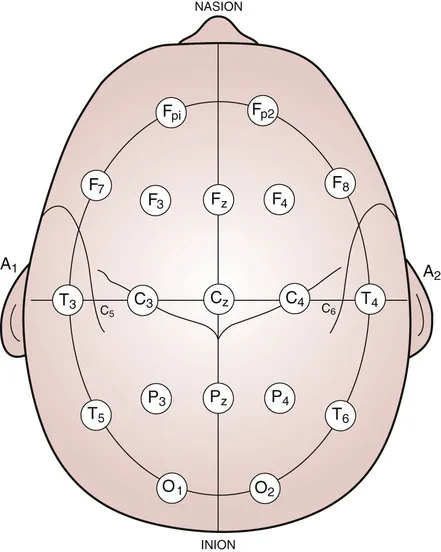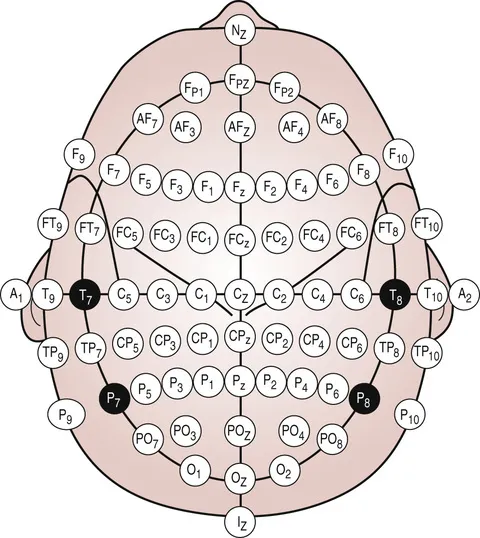
eBook - ePub
Rowan's Primer of EEG E-Book
Lara V. Marcuse, Madeline C. Fields, Ji Yeoun Jenna Yoo
This is a test
Condividi libro
- 208 pagine
- English
- ePUB (disponibile sull'app)
- Disponibile su iOS e Android
eBook - ePub
Rowan's Primer of EEG E-Book
Lara V. Marcuse, Madeline C. Fields, Ji Yeoun Jenna Yoo
Dettagli del libro
Anteprima del libro
Indice dei contenuti
Citazioni
Informazioni sul libro
The new edition of Rowan's Primer of EEG continues to provide clear, concise guidance on the difficult technical aspects of how to perform and interpret EEGs. Practical yet brief, it is perfectly suited for students, residents, and neurologists alike, while included reference material will be continually useful, even to the experienced doctor.
- Features brief, to-the-point text with easily understandable language for quick reference.
- Portable design makes it simple to carry anywhere.
- Concise, reader-friendly format features improved 4-color design and online quiz-format assessment questions within each chapter.
- Includes the new nomenclature for EEGs put forth by the American Clinical Neurophysiology Society.
- Features a greater focus on pediatrics content and includes online videos detailing clinical descriptions of seizures and EEG interpretation.
- Delivers a concise chart of the EEG changes through the neonatal period.
- Offers enhanced coverage of epilepsy syndromes with a quick-access chart highlighting age of onset, prognosis, clinical characteristics, and EEG characteristics.
Domande frequenti
Come faccio ad annullare l'abbonamento?
È semplicissimo: basta accedere alla sezione Account nelle Impostazioni e cliccare su "Annulla abbonamento". Dopo la cancellazione, l'abbonamento rimarrà attivo per il periodo rimanente già pagato. Per maggiori informazioni, clicca qui
È possibile scaricare libri? Se sì, come?
Al momento è possibile scaricare tramite l'app tutti i nostri libri ePub mobile-friendly. Anche la maggior parte dei nostri PDF è scaricabile e stiamo lavorando per rendere disponibile quanto prima il download di tutti gli altri file. Per maggiori informazioni, clicca qui
Che differenza c'è tra i piani?
Entrambi i piani ti danno accesso illimitato alla libreria e a tutte le funzionalità di Perlego. Le uniche differenze sono il prezzo e il periodo di abbonamento: con il piano annuale risparmierai circa il 30% rispetto a 12 rate con quello mensile.
Cos'è Perlego?
Perlego è un servizio di abbonamento a testi accademici, che ti permette di accedere a un'intera libreria online a un prezzo inferiore rispetto a quello che pagheresti per acquistare un singolo libro al mese. Con oltre 1 milione di testi suddivisi in più di 1.000 categorie, troverai sicuramente ciò che fa per te! Per maggiori informazioni, clicca qui.
Perlego supporta la sintesi vocale?
Cerca l'icona Sintesi vocale nel prossimo libro che leggerai per verificare se è possibile riprodurre l'audio. Questo strumento permette di leggere il testo a voce alta, evidenziandolo man mano che la lettura procede. Puoi aumentare o diminuire la velocità della sintesi vocale, oppure sospendere la riproduzione. Per maggiori informazioni, clicca qui.
Rowan's Primer of EEG E-Book è disponibile online in formato PDF/ePub?
Sì, puoi accedere a Rowan's Primer of EEG E-Book di Lara V. Marcuse, Madeline C. Fields, Ji Yeoun Jenna Yoo in formato PDF e/o ePub, così come ad altri libri molto apprezzati nelle sezioni relative a Medicine e Neurology. Scopri oltre 1 milione di libri disponibili nel nostro catalogo.
1
Origin and technical aspects of the EEG
Origin of the EEG
The EEG records electrical activity from the cerebral cortex. Inasmuch as electrocortical activity is measured in microvolts (µV), it must be amplified by a factor of 1,000,000 in order to be displayed on a computer screen. Most of what we record is felt to originate from neurons, and there are a number of possible sources including action potentials, post-synaptic potentials (PSPs), and chronic neuronal depolarization. Action potentials induce a brief (10 ms or less) local current in the axon with a very limited potential field. This makes them unlikely candidates. PSPs are considerably longer (50–200 ms), have a much greater field, and thus are more likely to be the primary generators of the EEG. Long-term depolarization of neurons or even glia could also play a role and produce EEG changes.
In the normal brain an action potential travels down the axon to the nerve terminal, where a neurotransmitter is released. However, it is the synaptic potentials that are the most important source for the electroencephalogram. The resting membrane potential (electrochemical equilibrium) is typically –70 mV on the inside. At the post-synaptic membrane the neurotransmitter produces a change in membrane conductance and transmembrane potential. If the signal has an excitatory effect on the neuron it leads to a local reduction of the transmembrane potential (depolarization) and is called an excitatory post-synaptic potential (EPSP), typically located in the dendrites. Note that during an EPSP the inside of the neuronal membrane becomes more positive while the extracellular matrix becomes more negative. Inhibitory post-synaptic potentials (IPSPs) result in local hyperpolarization typically located on the cell body of the neuron. The combination of EPSPs and IPSPs induces currents that flow within and around the neuron with a potential field sufficient to be recorded on the scalp. The EEG is essentially measuring these voltage changes in the extracellular matrix. It turns out that the typical duration of a PSP, 100 ms, is similar to the duration of the average alpha wave. The posterior dominant rhythm (PDR), consisting of sinusoidal or rhythmic alpha waves, is the basic rhythmic frequency of the normal awake adult brain.
It is easy to understand how complex neuronal electrical activity generates irregular EEG signals that translate into seemingly random and ever-changing EEG waves. Less obvious is the physiological explanation of the rhythmic character of certain EEG patterns seen both in sleep and wakefulness. The mechanisms underlying EEG rhythmicity, although not completely understood, are mediated through two main processes. The first is the interaction between cortex and thalamus. The activity of thalamic pacemaker cells leads to rhythmic cortical activation. For example, the cells in the nucleus reticularis of the thalamus have the pacing properties responsible for the generation of sleep spindles. The second is based on the functional properties of large neuronal networks in the cortex that have an intrinsic capacity for rhythmicity. The result of both mechanisms is the creation of recognizable EEG patterns, varying in different areas of neocortex that allow us to make sense of the complex world of brain waves.
Technical Considerations
The essence of electroencephalography is the amplification of tiny currents into a graphic representation that can be interpreted. Of course, extracerebral potentials are likewise amplified (movements and the like), and these are many times the amplitude of electrocortical potentials. Thus, unless understood and corrected for, such interference or artifacts obscure the underlying EEG. Like the archeologist, the epileptologist seeks to fully understand artifacts in order to discern the truth. Later, we will discuss artifacts in detail and illustrate clearly their many guises. At this point we will consider the technical factors that are indispensable in obtaining an interpretable record.
Electrodes
Electrodes are simply the means by which the electrocortical potentials are conducted to the amplification apparatus. Essentially, standard EEG electrodes are small, non-reactive metal discs or cups applied to the scalp with a conductive paste. Several types of metals are used including gold, silver/silver chloride, tin, and platinum. Electrode contact must be firm in order to ensure low impedance (resistance to current flow), thus minimizing both electrode and environmental artifacts. For long-term monitoring, especially if the patient is mobile, cup electrodes are affixed with collodion (a sort of glue), and a conductive gel is inserted between electrode and scalp through a small hole in the electrode itself. This procedure maintains recording integrity over prolonged periods.
Other types of electrodes are available including plastic, as well as needle electrodes. In fact, new plastic electrodes are MRI compatible. Needle electrodes, which in the past were often used in ICUs, have been redeveloped and consist of a painless (really!) subdermal electrode.
Electrode Placement
Electrode placement is standardized in the United States and indeed in most other nations. This allows EEGs performed in one laboratory to be interpreted in another. The general problem is to record activity from various parts of the cerebral cortex in a logical, interpretable manner. Thanks to Dr. Herbert Jasper, a renowned electroencephalographer at the Montreal Neurological Institute, we have a logical, generally accepted system of electrode placement: the 10-20 International System of Electrode Placement (Figure 1-1). The numbering has been slightly modified since the last edition to a 10-10 system (Figure 1-2). The system was modified so that if additional electrodes are to be placed on the scalp, there is a logical numbering system with which to do so.

Figure 1-1 10-20 system. A single-plane projection of the head showing all standard positions and the locations of the Rolandic and Sylvian fissures. The outer circle was drawn at the level of the nasion and inion. The inner circle represents the temporal line of electrodes.

Figure 1-2 10-10 system. The 10-20 system has been modified to standardize a method for adding more electrodes.
Both the 10-10 and the 10-20 system depend on accurate measurements of the skull, utilizing several distinctive landmarks. Essentially, a measurement of the skull is taken in three planes – sagittal, coronal, and horizontal. The summation of all the electrodes in any given plane will equal 100%. Electrodes designat...